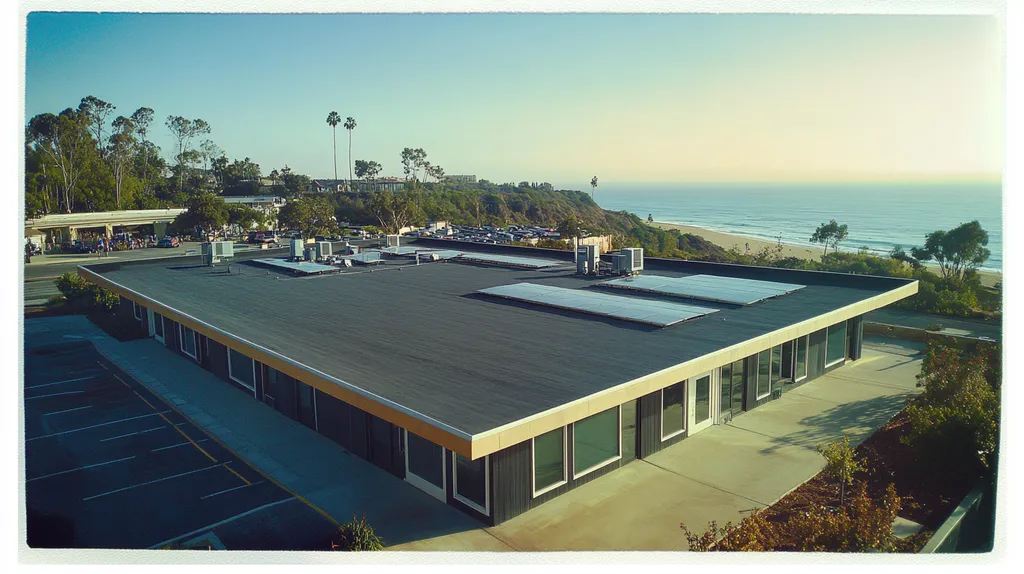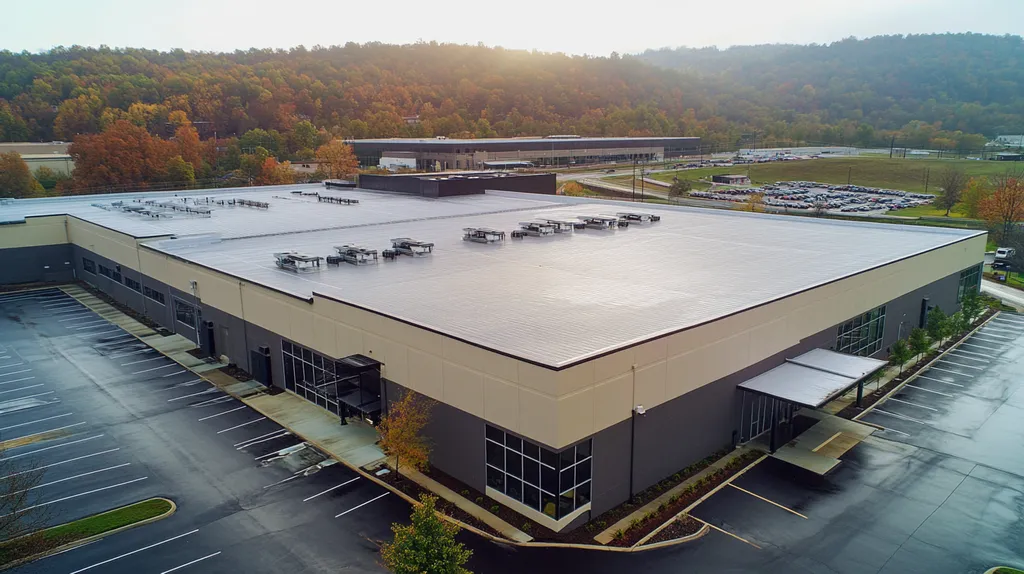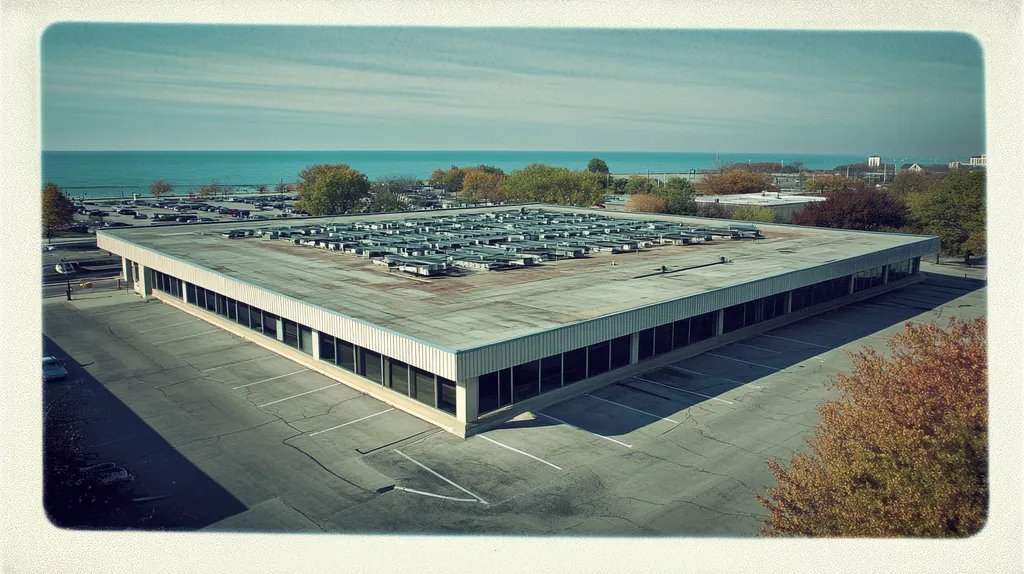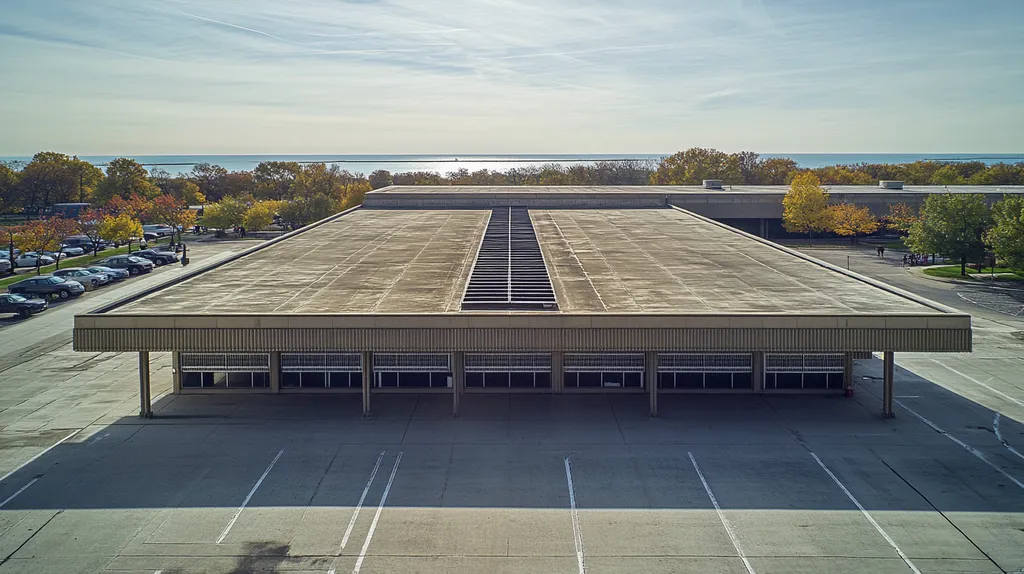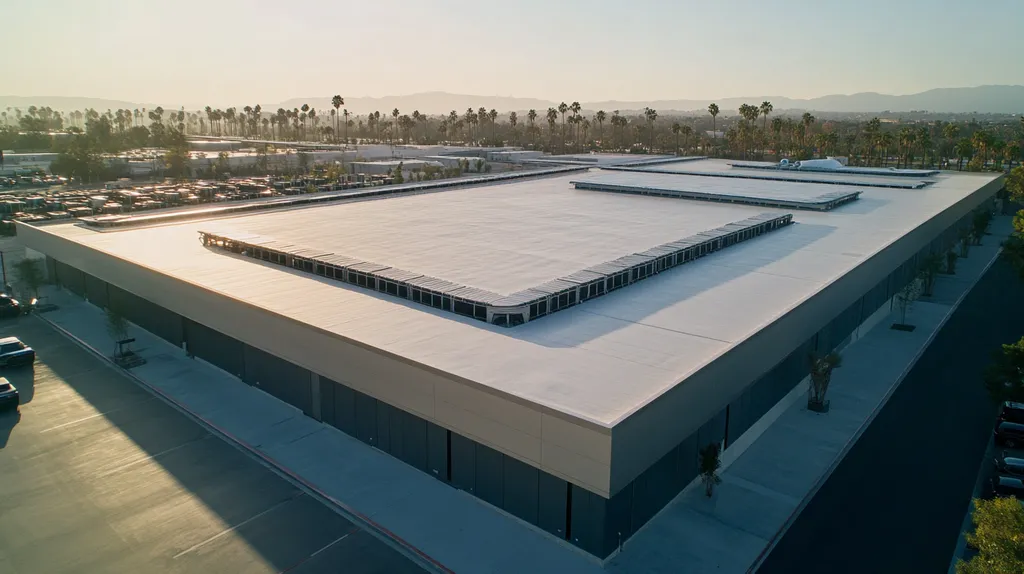Rising energy costs and strict environmental regulations are forcing commercial property owners to rethink their roofing choices. Studies show that selecting the wrong roof color can increase cooling costs by up to 40% annually.
The color of a commercial roof does more than define aesthetics – it dramatically impacts building energy efficiency, occupant comfort, and operational expenses. Recent advances in roofing technology and materials have created new opportunities for energy optimization through strategic color selection.
This comprehensive guide examines how roof color choices influence energy performance, from fundamental concepts like Solar Reflectance Index to practical implementation strategies that maximize efficiency and cost savings.
SECTION 1: FUNDAMENTAL CONCEPTS
With rising energy costs impacting budgets, the color of a commercial roof has become a vital consideration for energy efficiency. Property owners and facility managers must navigate the complexities of these choices, as selecting the wrong roof color can lead to inflated cooling expenses, discomfort for occupants, and detrimental effects on building sustainability. By grasping essential concepts like the Solar Reflectance Index (SRI) and the urban heat island effect, stakeholders can make informed decisions that contribute positively to their bottom line and the environment.
Understanding Solar Reflectance Index (SRI)
The Solar Reflectance Index (SRI) is crucial for assessing a roof’s energy performance. Combining both reflectance and emittance values of roofing materials, it provides a clear metric for how effectively a roof can reject solar heat. A higher SRI signifies improved energy efficiency and cooler surface temperatures, which can significantly decrease air conditioning demands.
For example, a roof with an SRI of 0.90 reflects 90% of solar radiation, while one with an SRI of 0.20 absorbs much of it. This difference can lead to substantial annual energy savings—potentially in the thousands of dollars. Thus, property owners should prioritize roofing materials with elevated SRI ratings during their selection process.
Utilizing cool roofing solutions can greatly enhance building performance. Facilities with cool roofs often reap benefits including lower energy costs and improved indoor comfort for occupants. Furthermore, as local building codes increasingly emphasize energy-efficient designs, understanding SRI becomes ever more critical.
In conclusion, the Solar Reflectance Index is a key determinant in evaluating the energy efficiency of roofing materials. By opting for materials with high SRI values, property owners can make more sustainable and financially sound decisions.
Role of Color in Heat Reflection and Emission
The color of a roof dramatically affects its competency in reflecting sunlight and releasing absorbed heat. Generally, lighter colors like white or pastel tones possess higher solar reflectivity compared to darker hues. This basic principle is vital for effective energy management in commercial buildings.
Research has shown that white or light-colored roofs can be up to 30% cooler than their dark counterparts. A lighter shade minimizes heat absorption, thus lowering indoor temperatures and energy consumption for cooling. This advantage is especially critical in warmer climates where air conditioning is frequently used.
Additionally, opting for light-colored roofing materials can ease the burden on local energy sources. This shift not only promotes sustainability initiatives but also aids efforts to combat climate change, as lower energy consumption contributes to reduced greenhouse gas emissions.
The color choice, therefore, plays a direct role in enhancing energy efficiency and ensuring the long-term performance of buildings. Property owners should consider selecting lighter shades for their roofing materials to maximize heat reflection and reduce energy expenditures.
Urban Heat Island Effect and Roof Color
The urban heat island effect poses a growing challenge in cities, where built environments trap heat and elevate local temperatures. Dark roofs substantially worsen this issue by absorbing solar energy and contributing to higher ambient temperatures. Making strategic roofing color choices can help alleviate these effects and foster a more sustainable urban landscape.
Studies indicate that cities with a higher prevalence of dark roofing materials often experience increased temperatures, leading to higher energy consumption and worsening air quality. By selecting reflective roof colors, property owners can play a meaningful role in mitigating these consequences, benefiting both their buildings and the surrounding environment.
Implementing cool roofs can dramatically reduce the heat island effect, resulting in lower city temperatures and bolstering urban climate resilience. This benefits building occupants and positively impacts the broader community.
The decision regarding roofing color holds the potential to transform urban environments into cooler, more sustainable areas. Stakeholders should embrace this opportunity to boost energy efficiency and contribute positively to local ecosystems.
SECTION 2: SYSTEM COMPONENTS
The selection of roofing materials and system components is a critical factor in enhancing energy efficiency and overall building performance. With energy costs on the rise, making informed choices is more important than ever. Studies indicate that adopting reflective roofing systems can trim cooling energy needs by up to 15%. Understanding the variety of material options available can create significant savings in energy consumption and bolster environmental sustainability.
Metal Roofing Materials and Properties
Metal roofing has become a top choice for property owners striving for energy efficiency. Available materials like steel, aluminum, and copper each boast distinct benefits. For instance, steel is celebrated for its durability and strength, while aluminum is prized for its lightweight and resistance to corrosion.
Applying a reflective coating can dramatically enhance the performance of a metal roof. This coating serves not only to shield the metal but also to minimize heat absorption. For commercial buildings, opting for a lighter-colored metal roof can further drive down energy costs by deflecting sunlight, consequently reducing both heating and cooling demands.
Moreover, metal roofing systems are adaptable and can be tailored to fit various architectural designs. Their longevity often surpasses that of traditional roofing materials, offering an impressive return on investment over time. Ensuring proper installation is crucial for optimizing energy performance.
In summary, the properties of metal roofing make it an excellent selection for energy-efficient commercial buildings. Investing in quality metal materials can generate substantial long-term savings on energy expenses.
Insulation and Underlayment Options
Insulation plays a pivotal role in maintaining a roof’s energy efficiency. Proper insulation minimizes heat transfer, crucial for both summer cooling and winter heating. The U.S. Department of Energy reports that effective insulation can cut energy costs by 30% or more.
Various types of insulation offer differing effectiveness levels. Rigid foam boards, spray foam, and fiberglass batts are among the most common options. Each material comes with an R-value, which quantifies thermal resistance. For instance, spray foam excels in air sealing and insulating compared to conventional fiberglass alternatives.
Underlayment is equally important for maximizing overall system performance. High-quality underlayment provides extra defense against moisture and air leaks, while also enhancing insulation properties. Selecting insulation and underlayment products rich in recycled content can further support sustainability goals.
Incorporating the right insulation and underlayment materials is critical to ensuring that the roofing system operates efficiently, leading to notable cost savings over time.
Radiant Barrier Technology
Radiant barrier technology offers an innovative solution to boost energy efficiency in commercial roofing. This technology employs reflective materials installed within the roof assembly. These barriers work by reflecting radiant heat away from the building, rather than allowing it to be absorbed.
Buildings that utilize radiant barriers can experience significant temperature reductions, notably during hotter months. Research shows that these barriers can achieve cooling savings of up to 17% in warm climates. This technology is particularly advantageous for flat roofs commonly found in commercial settings.
Effective installation is key when it comes to radiant barriers. They must be oriented to face the air space to optimize their reflective capabilities. Additionally, local climate conditions should influence decisions on their implementation.
Overall, radiant barrier technology represents a proactive step towards achieving higher energy efficiency. By integrating this technology into roofing systems, property owners can significantly reduce energy consumption and enhance indoor comfort.
SECTION 3: IMPLEMENTATION METHODS
The energy efficiency of a commercial roof is greatly influenced by its color. As energy costs continue to rise and climate challenges become more pressing, choosing the right roofing material and color is no longer just a preference; it’s a necessity. For example, the U.S. Department of Energy indicates that lighter-colored roofs can decrease cooling expenses by as much as 20%. By employing effective installation techniques and ensuring proper ventilation, property owners can amplify these benefits. This section will delve into various installation methods and their relationship to energy efficiency.
Installation Techniques for Metal Roofs
Metal roofs are a popular choice for commercial properties due to their durability and energy-saving potential. However, the method of installation plays a crucial role in overall performance. Thoughtful installation of metal roofs can enhance their ability to reflect solar heat, drastically lowering cooling costs.
To achieve optimal results, utilizing specialized fasteners and appropriate underlayment is essential. These components not only ensure the roof’s longevity but also boost its thermal efficiency. Installers should always consider local geography and climate conditions when selecting materials to maximize energy performance.
Additionally, precision in installation is key. Skilled roofers must minimize gaps and seams where unwanted heat might enter or escape. This attention to detail can significantly enhance the roof’s effectiveness in maintaining comfortable indoor temperatures.
By understanding the unique characteristics of metal roofing, property owners can make informed decisions that maximize energy savings. It’s imperative to engage contractors who specialize in metal roofs to achieve the desired outcomes.
Batten vs. Direct-to-Deck Installation
The choice between batten and direct-to-deck installation can have a substantial impact on a roof’s thermal efficiency. Batten installation employs raised strips that create an airspace, which can enhance ventilation, while direct-to-deck places the roofing material flat against the deck.
Choosing batten installation allows for improved airflow that helps reduce heat accumulation. This is particularly beneficial in warmer climates where cooling expenses can escalate. The airspace created acts as an insulation layer, further enhancing energy performance.
On the other hand, direct-to-deck methods may be quicker and less expensive but can lead to heat retention, which drives up energy costs. Property owners must balance upfront costs with potential long-term savings when selecting an installation method.
Consulting roofing professionals can provide valuable insights tailored to specific climate conditions and building usage, ensuring that the chosen method supports enhanced energy efficiency and reduced operational costs.
Ventilation and Airspace Considerations
Proper ventilation is vital for enhancing the energy efficiency of commercial roofs. Adequate airflow helps prevent heat buildup and keeps the building interior cooler. Insufficient ventilation can lead to premature roof failures, resulting in costly repairs down the line.
A well-designed ventilation system extends roof life and reduces problems such as ice dams and moisture accumulation, which are especially problematic in regions with fluctuating temperatures.
Moreover, incorporating airspace into the roofing system can provide an additional buffer, allowing heat to dissipate rather than infiltrate the building’s interior. By integrating these design elements, property owners can significantly reduce energy costs.
Materials and techniques that optimize ventilation are essential for maximizing energy efficiency. Investing in these features from the outset can lead to impressive savings on energy bills over time.
SECTION 4: MAINTENANCE REQUIREMENTS
Maintaining a commercial roof is not just good practice; it’s essential for maximizing energy efficiency and extending the roof’s lifespan. Studies suggest that consistent upkeep can increase a roof’s lifespan by up to 30%. Neglecting regular maintenance can lead to significant repair costs and a rise in energy consumption, putting pressure on your budget and sustainability goals.
Regular Inspection and Repair Needs
Routine inspections are vital for spotting wear and tear before they escalate into serious issues. A semi-annual inspection schedule enables facility managers to identify minor leaks or damp areas early on. For example, even a tiny crack can lead to significant water infiltration, resulting in increased energy use and compromised insulation.
During these inspections, roofing professionals should closely examine seams, flashings, and the overall membrane integrity. These areas are particularly vulnerable to damage. Keeping a detailed record of inspections helps track the roof’s condition, supporting informed decision-making. Without this regular oversight, even minor issues can turn into major financial burdens.
Timely repairs also play a crucial role in boosting energy efficiency. Sealing small gaps can prevent conditioned air from escaping, ultimately lowering energy expenses for heating and cooling. This leads to directly noticeable savings on utility bills.
Property owners are encouraged to implement a proactive repair strategy. Addressing issues promptly minimizes the risk of more extensive damage and helps adhere to warranty requirements. Regular monitoring ultimately strengthens the roof against sudden failures.
Cleaning and Coating Maintenance
Regular cleaning is essential for maintaining a commercial roof’s energy efficiency. Accumulated debris, such as leaves and dirt, can trap heat and diminish the roof’s sunlight reflection capabilities. This can significantly increase cooling costs during hot seasonal months.
A cleaning routine should include both debris removal and inspections for algae or mold growth. Neglecting these aspects can deteriorate roofing materials and impair performance. Additionally, applying reflective coatings regularly can enhance a roof’s ability to repel sunlight, which further boosts energy efficiency.
High-quality coatings not only improve thermal performance but also prolong the roof’s life. For instance, a roof treated with the right reflective coating can reflect up to 80% of solar radiation, leading to dramatically reduced indoor temperatures and lesser reliance on air conditioning during peak heat periods.
It’s vital to integrate coating maintenance into the overall upkeep budget. Investing in high-quality materials can significantly reduce the long-term costs linked to premature roof replacement.
Ensuring Long-Term Durability
Ensuring long-term durability requires a carefully crafted maintenance plan tailored to the roofing system in place. The choice of materials and color can significantly affect energy efficiency and the type of maintenance required.
Consulting with roofing experts can provide insights into the expected lifespan and maintenance needs of specific roofing materials. For instance, options like TPO or PVC typically demand less frequent upkeep compared to others. Choosing the right roofing system can lead to fewer maintenance responsibilities over time.
Technology such as roof monitoring systems can deliver real-time insights into roof conditions. This proactive approach allows property owners to resolve issues before they escalate into costly repairs, ensuring the roof remains in excellent condition. Furthermore, monitoring effectiveness over the years helps evaluate the success of maintenance strategies.
Finally, providing regular training for maintenance crews on the nuances of the roofing system can yield numerous benefits. Knowledgeable staff can quickly identify potential issues and intervene before they become significant problems, promoting both energy efficiency and the roof’s overall lifespan.
SECTION 5: PERFORMANCE METRICS
Understanding performance metrics for commercial roofs is critical for property owners and facility managers. The color choice of a roof can have a direct effect on energy efficiency and operational costs. For instance, reflective roofing systems can lower cooling energy consumption by as much as 40% compared to traditional dark roofs. This section explores how to effectively measure energy savings, the importance of LEED certifications, and how regional factors and roof pitch can play a significant role in roofing performance.
Measuring Energy Efficiency Savings
To accurately assess energy efficiency savings, property owners should compare energy consumption metrics before and after roof modifications. Energy modeling software can simulate expected energy usage changes driven by roof color, insulation properties, and regional climate. For example, switching from a dark to a light-colored roof frequently results in significant decreases in cooling expenses, which can be quantified by analyzing historical energy bills.
Data logging and monitoring systems provide valuable insights into real-time energy performance. These systems enable facility managers to track energy use, ensuring they can gauge the effectiveness of their roofing decisions. Establishing a baseline energy usage level prior to making any roofing changes is essential for accurate savings measurement.
Incorporating sub-meters for HVAC systems can help isolate energy savings attributed directly to roofing changes. This targeted approach delivers precise data, reinforcing the value of selecting energy-efficient roofing solutions.
Ultimately, effective measurement not only assists with current operational decisions but also nurtures better planning and budgeting for future property upgrades.
LEED Certifications and Compliance
LEED (Leadership in Energy and Environmental Design) certifications significantly enhance a property’s value while supporting sustainability efforts. A cool roof contributes valuable LEED credits, especially within the Energy and Atmosphere category. Achieving LEED certification can yield benefits like reduced energy costs, potential tax incentives, and increased market visibility.
Property owners should familiarize themselves with LEED requirements related to roofing materials. For instance, reflective roofing must meet specific solar reflectance standards to earn credits, directly influencing initial investment decisions.
Compliance with LEED standards not only shows a commitment to sustainability but can also enhance a property’s attractiveness to environmentally conscious tenants. Participating in green-building ratings could eventually improve tenant retention and draw a more sustainable clientele.
Regular audits and roof evaluations are vital to maintaining compliance. This ensures that energy-efficient properties continue to perform well and retain their LEED-certified status.
Impact of Region and Roof Pitch
The climate of a region profoundly influences the effectiveness of roofing colors and materials. In warmer areas, lighter-colored roofs provide superior sunlight reflection and cooling, while regions with cooler climates may not need to prioritize reflectivity due to greater heating demands.
Roof pitch is another significant factor affecting energy efficiency. Steeper roofs generally facilitate better drainage and ventilation, but the choice of color plays a critical role. For instance, a flat roof in a hot climate often benefits more from reflective coatings than a steep roof would.
By understanding how regional conditions and roof pitch interact, property owners can make well-informed roofing decisions. Local building codes may also impose specific energy efficiency criteria, highlighting the necessity of aligning roofing strategies with jurisdictional standards.
Integrating these considerations enables property owners to optimize roofing performance, ultimately maximizing energy savings and enhancing overall metrics in the long run.
SECTION 5: PERFORMANCE METRICS
Understanding performance metrics for commercial roofs is essential for property owners and facility managers. The impact of color choice on energy efficiency can significantly influence operational costs. For example, reflective roofing systems can lower cooling energy consumption by as much as 40% compared to traditional dark roofs. This section will break down how to measure energy efficiency savings, the importance of LEED certifications, and the role that regional factors and roof pitch play in roofing performance.
Measuring Energy Efficiency Savings
To effectively assess energy efficiency savings, property owners should analyze energy consumption before and after implementing roofing changes. Energy modeling software can simulate how roof color, insulation properties, and climate combine to affect energy use. For instance, switching from a dark to a light-colored roof often leads to noticeable reductions in cooling costs, quantifiable through historical energy bills.
In addition, data logging and monitoring systems provide real-time insights into energy performance. These tools enable facility managers to track energy use effectively, helping them to understand the impact of their roofing choices. It’s crucial to establish a baseline measurement prior to any roofing modifications to accurately gauge savings.
Implementing sub-meters specifically for HVAC systems can help isolate energy savings directly attributed to roofing changes. This targeted approach provides valuable, precise data that reinforces the advantages of selecting energy-efficient roofing options.
Ultimately, thorough measurement not only supports current operational decisions but also enhances planning and budgeting for future property upgrades.
LEED Certifications and Compliance
LEED (Leadership in Energy and Environmental Design) certifications significantly boost a property’s value and commitment to sustainability. Cool roofs can earn valuable LEED credits, particularly in the Energy and Atmosphere category, leading to reduced energy costs and potential tax incentives.
Property owners should understand LEED requirements that pertain to roofing materials. For example, reflective roofing must meet specific solar reflectance values to gain credits, which can affect investment decisions. Compliance with these standards demonstrates a dedication to sustainability that attracts eco-conscious tenants.
By participating in green-building ratings, property owners can enhance tenant retention and appeal to a more sustainable clientele. Maintaining compliance requires regular audits and roof evaluations to ensure that the roofing system consistently meets energy efficiency standards over time.
Impact of Region and Roof Pitch
The climate in a particular region plays a pivotal role in determining the most effective roofing colors and materials. For example, in warmer areas, lighter-colored roofs excel at reflecting sunlight and maintaining cooler building temperatures, while in cooler climates, this focus on reflectivity may be less critical due to higher heating needs.
Roof pitch is another significant factor affecting energy efficiency. Steeper roofs typically offer better drainage and ventilation, but the color’s influence on energy savings must align with local conditions. For instance, a flat roof in a hot climate is likely to benefit more from reflective coatings than a steeply pitched roof.
Understanding how regional conditions and roof pitch interact allows property owners to make more informed roofing choices. Additionally, local building codes may impose specific energy efficiency standards, underscoring the need to align roofing strategies with regional requirements.
Integrating these considerations empowers property owners to optimize roofing performance, maximizing energy savings and enhancing overall metrics in the long run.
Looking Ahead
With energy costs projected to rise 30% over the next decade, selecting the right roof color is no longer optional for commercial property owners – it’s an economic imperative.
The data clearly shows that strategic color selection, combined with proper installation and maintenance, can reduce cooling costs by up to 40% while extending roof lifespan by 15-20 years.
Advanced materials and cool-roof technologies continue to evolve, offering property owners unprecedented opportunities to optimize energy efficiency through informed color choices.
As regulations tighten and sustainability becomes increasingly crucial for property values, implementing these proven strategies for roof color selection will separate industry leaders from those left paying unnecessarily high energy bills.
The future of commercial roofing lies in this intelligent integration of color science and energy efficiency – the time to act is now.
FREQUENTLY ASKED QUESTIONS
Q. How does the color of a commercial roof affect energy efficiency?
A. The color of a roof influences how much sunlight it reflects. Lighter roofs reflect more sunlight, leading to cooler indoor temperatures and reduced reliance on air conditioning. This ultimately results in lower energy costs and improved occupant comfort, especially in warmer climates.
Q. What roofing materials are best for a commercial roof’s energy efficiency?
A. Metal roofing materials, such as aluminum and steel, are excellent choices for energy efficiency. They can be enhanced with reflective coatings, which minimize heat absorption. Additionally, incorporating effective insulation and underlayment further boosts the roof’s performance in reducing energy costs.
Q. What installation methods can maximize energy efficiency in an industrial roof?
A. Batten installation creates airspace for better ventilation, helping to regulate heat. Direct-to-deck installation, while faster, can trap heat and increase energy costs. Proper ventilation and airspace considerations during installation can dramatically enhance the energy efficiency of an industrial roof.
Q. How often should a commercial roof be inspected for maintenance?
A. It’s recommended to inspect a commercial roof at least twice a year, typically in spring and fall. Regular inspections help identify any wear or damage early, preventing minor issues from escalating into costly repairs and ensuring optimal energy efficiency throughout the year.
Q. What are effective ways to measure energy efficiency savings in commercial roofs?
A. Property owners can measure energy savings by comparing utility bills before and after roofing changes. Utilizing energy modeling software and monitoring systems can provide real-time insights into energy performance, establishing a baseline for accurate analysis of energy savings achieved through roofing modifications.
Q. How do local climate conditions affect the choice of roof color and materials?
A. Climate conditions dictate the effectiveness of roof colors and materials. In warmer regions, lighter colors are preferable for better heat reflection. Conversely, in cooler climates, dark colors may be beneficial for warming the building. Regional climate should inform roofing decisions to maximize energy efficiency.
Q. What additional steps can enhance my commercial roof’s energy efficiency?
A. Implementing reflective coatings, ensuring proper insulation, and optimizing ventilation are key steps. Investing in technologies like radiant barriers can further minimize heat absorption. Additionally, engaging maintenance crews trained in energy-efficient practices enhances long-term roof performance and sustainability, leading to enduring energy savings.


